Code of Conduct
VerifiedAdded on 2022/12/15
|11
|2593
|470
AI Summary
The code of conduct of National Australia Bank focuses on maintaining a trusted reputation and describes the standards that all members must follow. It covers issues such as discrimination, exploitation, corruption, and dishonest behavior.
Contribute Materials
Your contribution can guide someone’s learning journey. Share your
documents today.
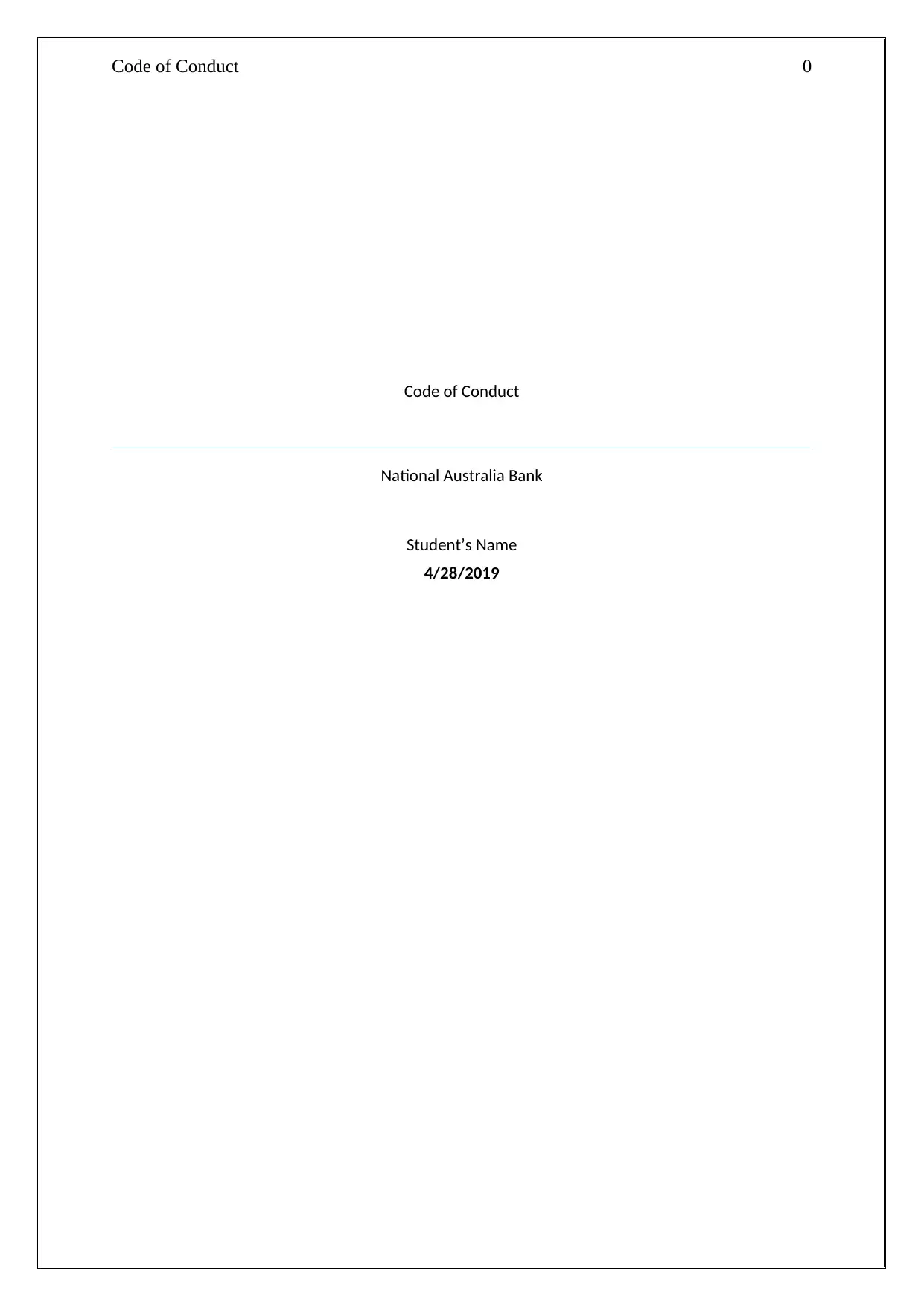
Code of Conduct 0
Code of Conduct
National Australia Bank
Student’s Name
4/28/2019
Code of Conduct
National Australia Bank
Student’s Name
4/28/2019
Secure Best Marks with AI Grader
Need help grading? Try our AI Grader for instant feedback on your assignments.
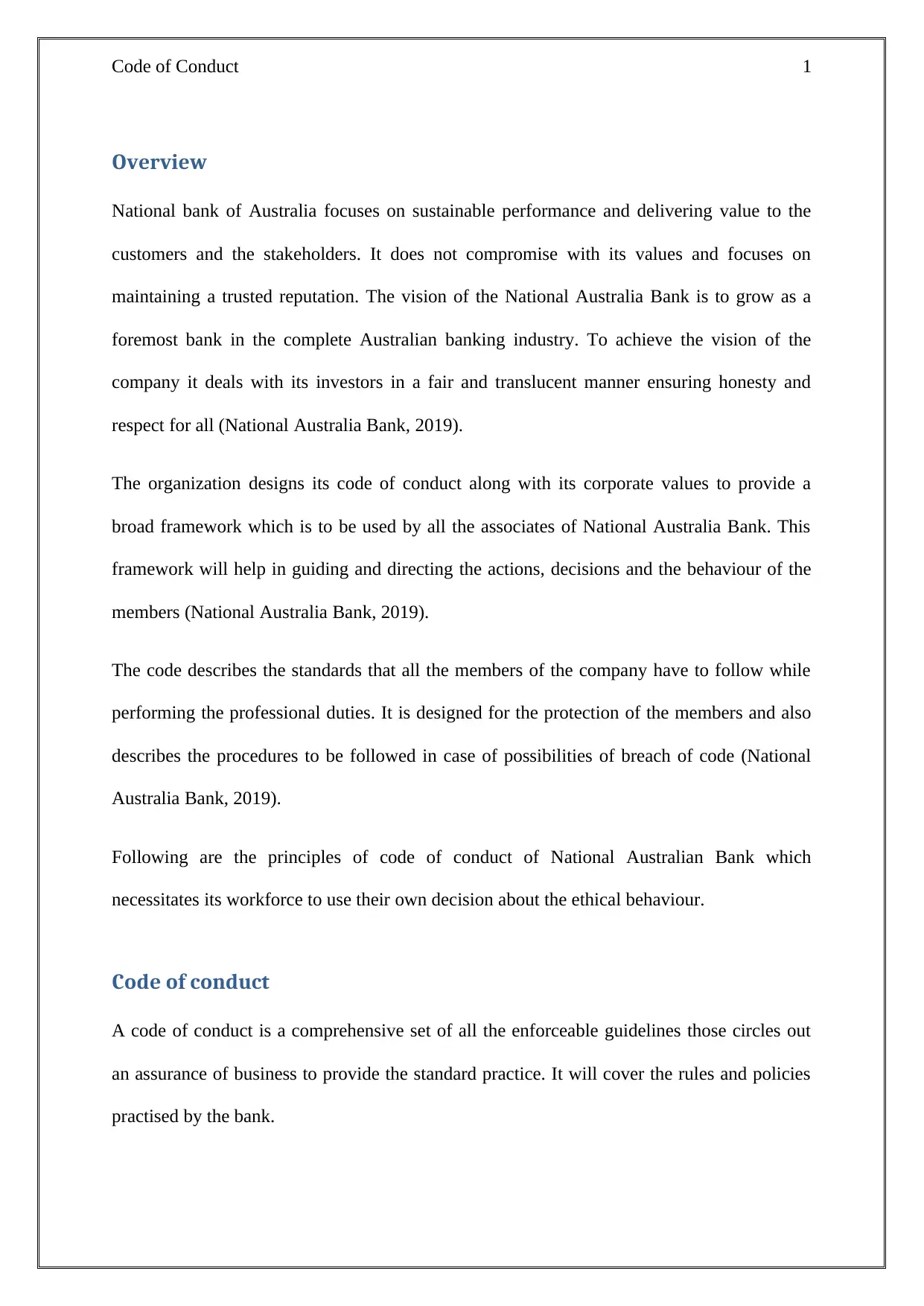
Code of Conduct 1
Overview
National bank of Australia focuses on sustainable performance and delivering value to the
customers and the stakeholders. It does not compromise with its values and focuses on
maintaining a trusted reputation. The vision of the National Australia Bank is to grow as a
foremost bank in the complete Australian banking industry. To achieve the vision of the
company it deals with its investors in a fair and translucent manner ensuring honesty and
respect for all (National Australia Bank, 2019).
The organization designs its code of conduct along with its corporate values to provide a
broad framework which is to be used by all the associates of National Australia Bank. This
framework will help in guiding and directing the actions, decisions and the behaviour of the
members (National Australia Bank, 2019).
The code describes the standards that all the members of the company have to follow while
performing the professional duties. It is designed for the protection of the members and also
describes the procedures to be followed in case of possibilities of breach of code (National
Australia Bank, 2019).
Following are the principles of code of conduct of National Australian Bank which
necessitates its workforce to use their own decision about the ethical behaviour.
Code of conduct
A code of conduct is a comprehensive set of all the enforceable guidelines those circles out
an assurance of business to provide the standard practice. It will cover the rules and policies
practised by the bank.
Overview
National bank of Australia focuses on sustainable performance and delivering value to the
customers and the stakeholders. It does not compromise with its values and focuses on
maintaining a trusted reputation. The vision of the National Australia Bank is to grow as a
foremost bank in the complete Australian banking industry. To achieve the vision of the
company it deals with its investors in a fair and translucent manner ensuring honesty and
respect for all (National Australia Bank, 2019).
The organization designs its code of conduct along with its corporate values to provide a
broad framework which is to be used by all the associates of National Australia Bank. This
framework will help in guiding and directing the actions, decisions and the behaviour of the
members (National Australia Bank, 2019).
The code describes the standards that all the members of the company have to follow while
performing the professional duties. It is designed for the protection of the members and also
describes the procedures to be followed in case of possibilities of breach of code (National
Australia Bank, 2019).
Following are the principles of code of conduct of National Australian Bank which
necessitates its workforce to use their own decision about the ethical behaviour.
Code of conduct
A code of conduct is a comprehensive set of all the enforceable guidelines those circles out
an assurance of business to provide the standard practice. It will cover the rules and policies
practised by the bank.
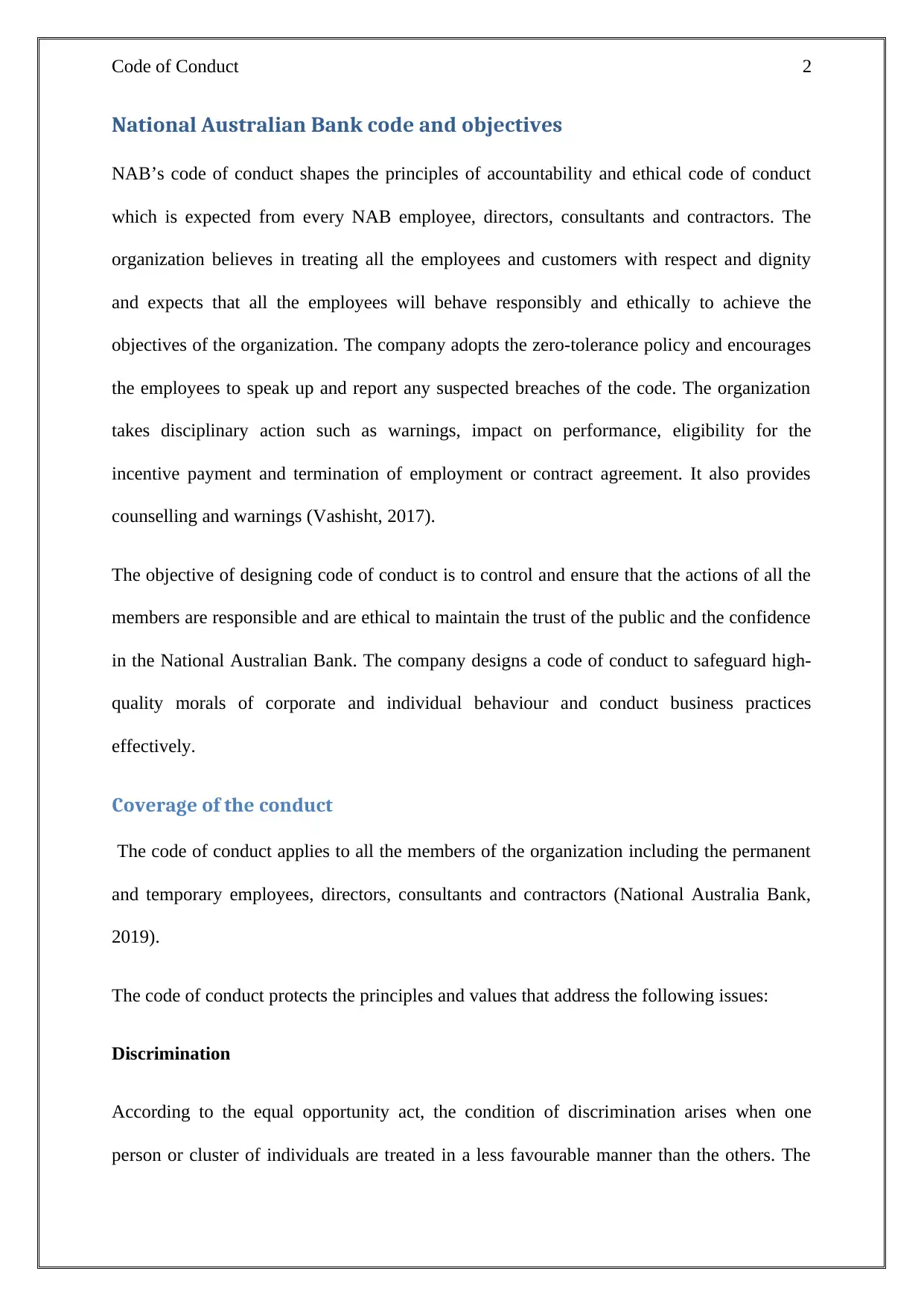
Code of Conduct 2
National Australian Bank code and objectives
NAB’s code of conduct shapes the principles of accountability and ethical code of conduct
which is expected from every NAB employee, directors, consultants and contractors. The
organization believes in treating all the employees and customers with respect and dignity
and expects that all the employees will behave responsibly and ethically to achieve the
objectives of the organization. The company adopts the zero-tolerance policy and encourages
the employees to speak up and report any suspected breaches of the code. The organization
takes disciplinary action such as warnings, impact on performance, eligibility for the
incentive payment and termination of employment or contract agreement. It also provides
counselling and warnings (Vashisht, 2017).
The objective of designing code of conduct is to control and ensure that the actions of all the
members are responsible and are ethical to maintain the trust of the public and the confidence
in the National Australian Bank. The company designs a code of conduct to safeguard high-
quality morals of corporate and individual behaviour and conduct business practices
effectively.
Coverage of the conduct
The code of conduct applies to all the members of the organization including the permanent
and temporary employees, directors, consultants and contractors (National Australia Bank,
2019).
The code of conduct protects the principles and values that address the following issues:
Discrimination
According to the equal opportunity act, the condition of discrimination arises when one
person or cluster of individuals are treated in a less favourable manner than the others. The
National Australian Bank code and objectives
NAB’s code of conduct shapes the principles of accountability and ethical code of conduct
which is expected from every NAB employee, directors, consultants and contractors. The
organization believes in treating all the employees and customers with respect and dignity
and expects that all the employees will behave responsibly and ethically to achieve the
objectives of the organization. The company adopts the zero-tolerance policy and encourages
the employees to speak up and report any suspected breaches of the code. The organization
takes disciplinary action such as warnings, impact on performance, eligibility for the
incentive payment and termination of employment or contract agreement. It also provides
counselling and warnings (Vashisht, 2017).
The objective of designing code of conduct is to control and ensure that the actions of all the
members are responsible and are ethical to maintain the trust of the public and the confidence
in the National Australian Bank. The company designs a code of conduct to safeguard high-
quality morals of corporate and individual behaviour and conduct business practices
effectively.
Coverage of the conduct
The code of conduct applies to all the members of the organization including the permanent
and temporary employees, directors, consultants and contractors (National Australia Bank,
2019).
The code of conduct protects the principles and values that address the following issues:
Discrimination
According to the equal opportunity act, the condition of discrimination arises when one
person or cluster of individuals are treated in a less favourable manner than the others. The
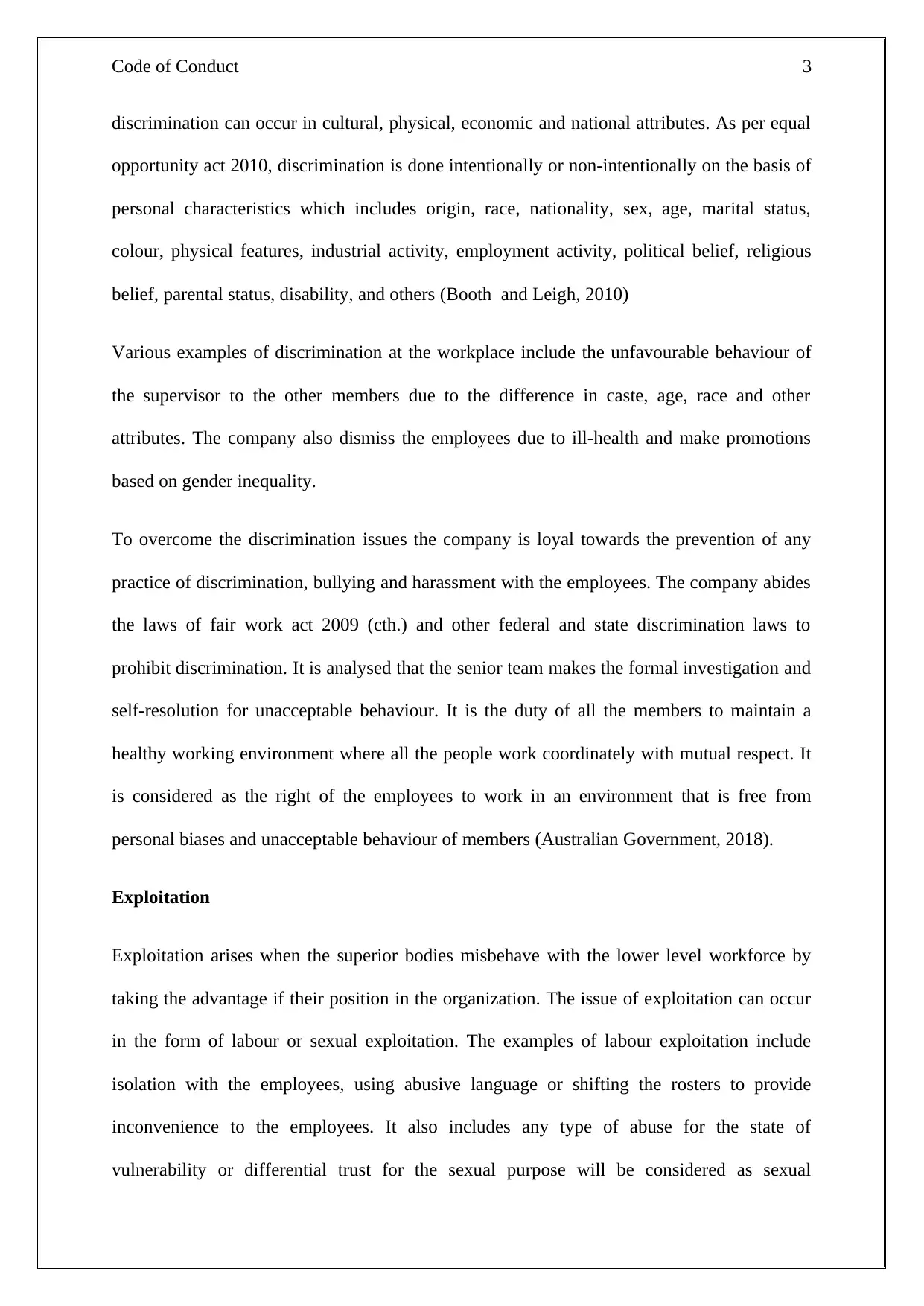
Code of Conduct 3
discrimination can occur in cultural, physical, economic and national attributes. As per equal
opportunity act 2010, discrimination is done intentionally or non-intentionally on the basis of
personal characteristics which includes origin, race, nationality, sex, age, marital status,
colour, physical features, industrial activity, employment activity, political belief, religious
belief, parental status, disability, and others (Booth and Leigh, 2010)
Various examples of discrimination at the workplace include the unfavourable behaviour of
the supervisor to the other members due to the difference in caste, age, race and other
attributes. The company also dismiss the employees due to ill-health and make promotions
based on gender inequality.
To overcome the discrimination issues the company is loyal towards the prevention of any
practice of discrimination, bullying and harassment with the employees. The company abides
the laws of fair work act 2009 (cth.) and other federal and state discrimination laws to
prohibit discrimination. It is analysed that the senior team makes the formal investigation and
self-resolution for unacceptable behaviour. It is the duty of all the members to maintain a
healthy working environment where all the people work coordinately with mutual respect. It
is considered as the right of the employees to work in an environment that is free from
personal biases and unacceptable behaviour of members (Australian Government, 2018).
Exploitation
Exploitation arises when the superior bodies misbehave with the lower level workforce by
taking the advantage if their position in the organization. The issue of exploitation can occur
in the form of labour or sexual exploitation. The examples of labour exploitation include
isolation with the employees, using abusive language or shifting the rosters to provide
inconvenience to the employees. It also includes any type of abuse for the state of
vulnerability or differential trust for the sexual purpose will be considered as sexual
discrimination can occur in cultural, physical, economic and national attributes. As per equal
opportunity act 2010, discrimination is done intentionally or non-intentionally on the basis of
personal characteristics which includes origin, race, nationality, sex, age, marital status,
colour, physical features, industrial activity, employment activity, political belief, religious
belief, parental status, disability, and others (Booth and Leigh, 2010)
Various examples of discrimination at the workplace include the unfavourable behaviour of
the supervisor to the other members due to the difference in caste, age, race and other
attributes. The company also dismiss the employees due to ill-health and make promotions
based on gender inequality.
To overcome the discrimination issues the company is loyal towards the prevention of any
practice of discrimination, bullying and harassment with the employees. The company abides
the laws of fair work act 2009 (cth.) and other federal and state discrimination laws to
prohibit discrimination. It is analysed that the senior team makes the formal investigation and
self-resolution for unacceptable behaviour. It is the duty of all the members to maintain a
healthy working environment where all the people work coordinately with mutual respect. It
is considered as the right of the employees to work in an environment that is free from
personal biases and unacceptable behaviour of members (Australian Government, 2018).
Exploitation
Exploitation arises when the superior bodies misbehave with the lower level workforce by
taking the advantage if their position in the organization. The issue of exploitation can occur
in the form of labour or sexual exploitation. The examples of labour exploitation include
isolation with the employees, using abusive language or shifting the rosters to provide
inconvenience to the employees. It also includes any type of abuse for the state of
vulnerability or differential trust for the sexual purpose will be considered as sexual
Secure Best Marks with AI Grader
Need help grading? Try our AI Grader for instant feedback on your assignments.
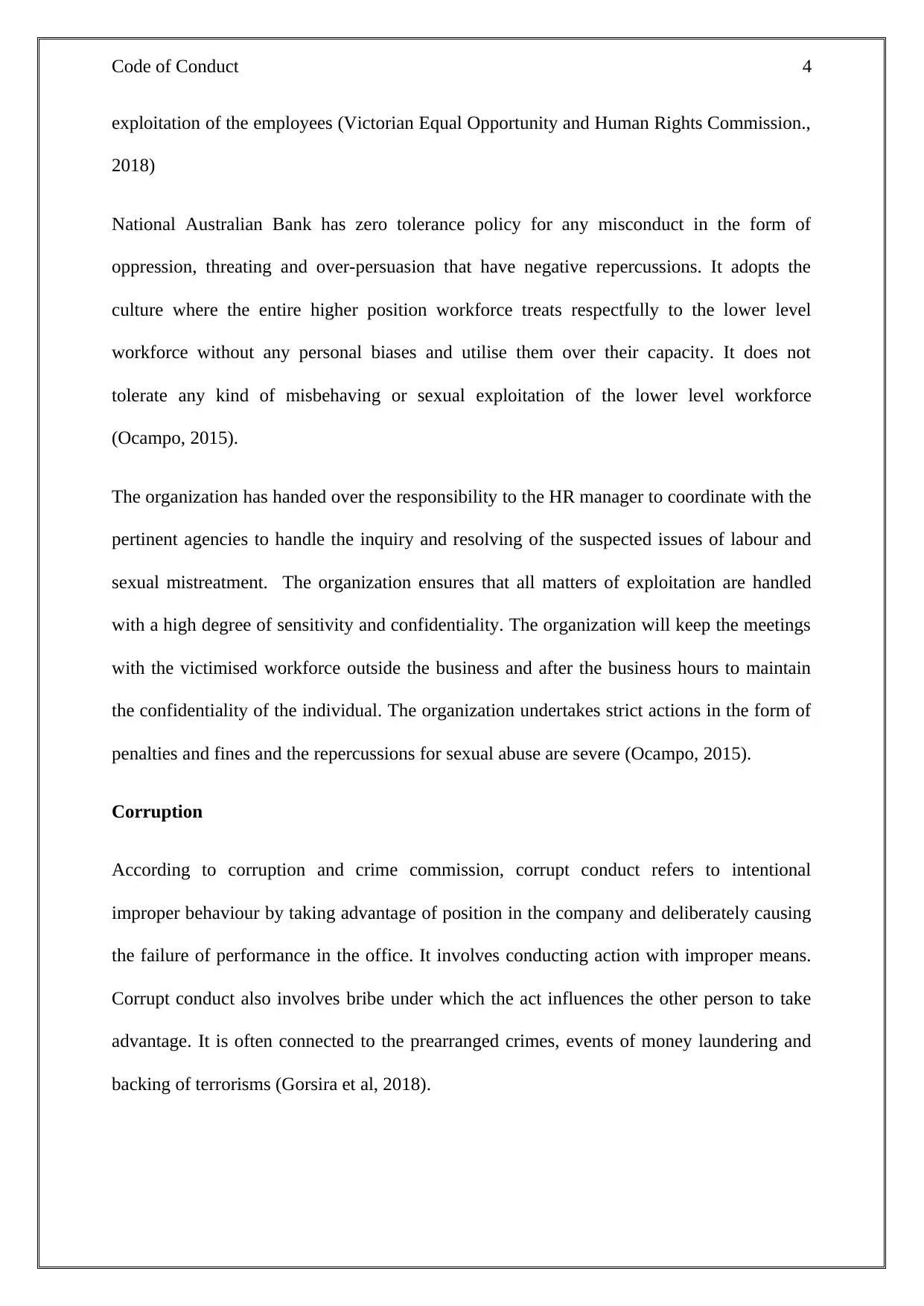
Code of Conduct 4
exploitation of the employees (Victorian Equal Opportunity and Human Rights Commission.,
2018)
National Australian Bank has zero tolerance policy for any misconduct in the form of
oppression, threating and over-persuasion that have negative repercussions. It adopts the
culture where the entire higher position workforce treats respectfully to the lower level
workforce without any personal biases and utilise them over their capacity. It does not
tolerate any kind of misbehaving or sexual exploitation of the lower level workforce
(Ocampo, 2015).
The organization has handed over the responsibility to the HR manager to coordinate with the
pertinent agencies to handle the inquiry and resolving of the suspected issues of labour and
sexual mistreatment. The organization ensures that all matters of exploitation are handled
with a high degree of sensitivity and confidentiality. The organization will keep the meetings
with the victimised workforce outside the business and after the business hours to maintain
the confidentiality of the individual. The organization undertakes strict actions in the form of
penalties and fines and the repercussions for sexual abuse are severe (Ocampo, 2015).
Corruption
According to corruption and crime commission, corrupt conduct refers to intentional
improper behaviour by taking advantage of position in the company and deliberately causing
the failure of performance in the office. It involves conducting action with improper means.
Corrupt conduct also involves bribe under which the act influences the other person to take
advantage. It is often connected to the prearranged crimes, events of money laundering and
backing of terrorisms (Gorsira et al, 2018).
exploitation of the employees (Victorian Equal Opportunity and Human Rights Commission.,
2018)
National Australian Bank has zero tolerance policy for any misconduct in the form of
oppression, threating and over-persuasion that have negative repercussions. It adopts the
culture where the entire higher position workforce treats respectfully to the lower level
workforce without any personal biases and utilise them over their capacity. It does not
tolerate any kind of misbehaving or sexual exploitation of the lower level workforce
(Ocampo, 2015).
The organization has handed over the responsibility to the HR manager to coordinate with the
pertinent agencies to handle the inquiry and resolving of the suspected issues of labour and
sexual mistreatment. The organization ensures that all matters of exploitation are handled
with a high degree of sensitivity and confidentiality. The organization will keep the meetings
with the victimised workforce outside the business and after the business hours to maintain
the confidentiality of the individual. The organization undertakes strict actions in the form of
penalties and fines and the repercussions for sexual abuse are severe (Ocampo, 2015).
Corruption
According to corruption and crime commission, corrupt conduct refers to intentional
improper behaviour by taking advantage of position in the company and deliberately causing
the failure of performance in the office. It involves conducting action with improper means.
Corrupt conduct also involves bribe under which the act influences the other person to take
advantage. It is often connected to the prearranged crimes, events of money laundering and
backing of terrorisms (Gorsira et al, 2018).
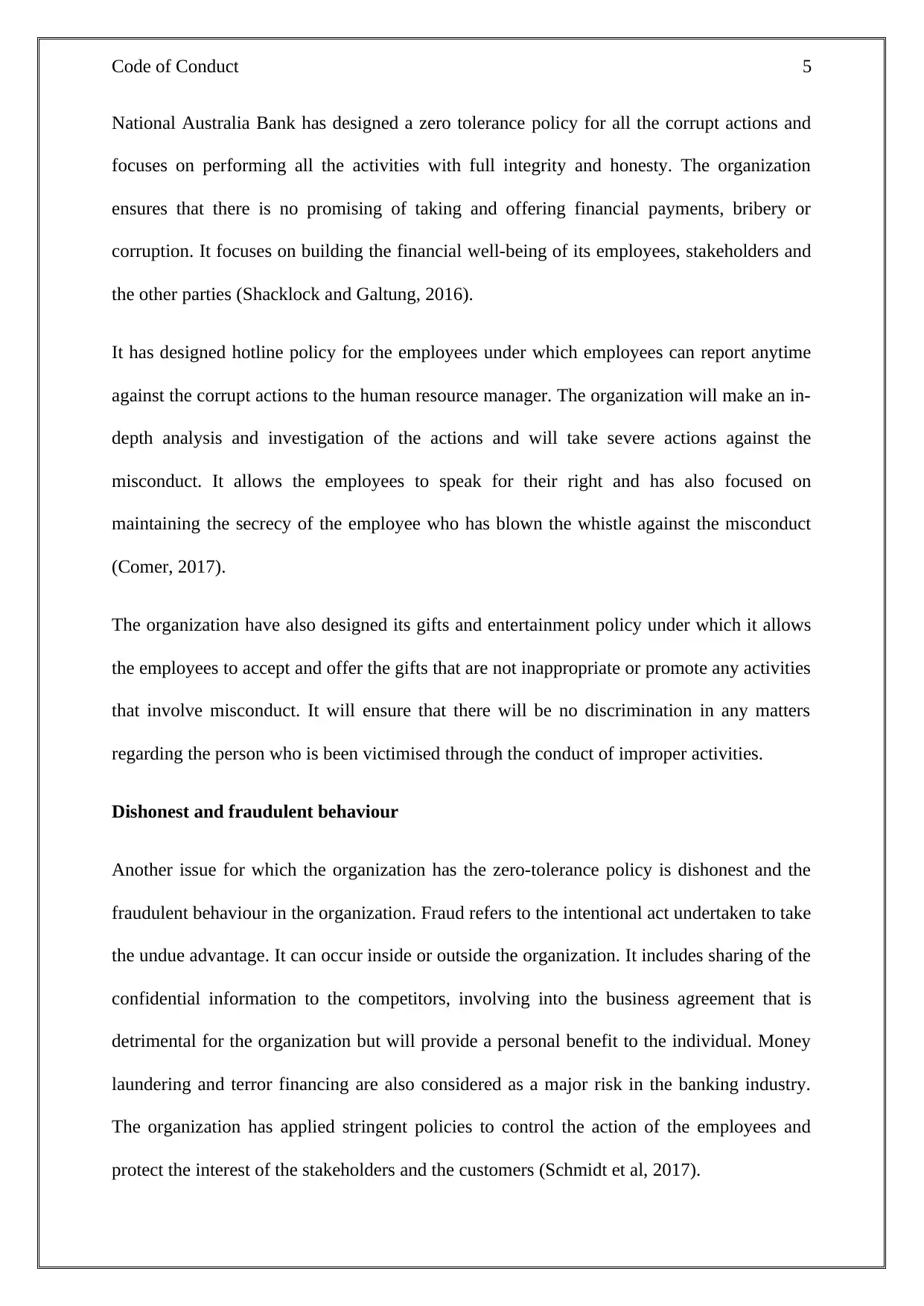
Code of Conduct 5
National Australia Bank has designed a zero tolerance policy for all the corrupt actions and
focuses on performing all the activities with full integrity and honesty. The organization
ensures that there is no promising of taking and offering financial payments, bribery or
corruption. It focuses on building the financial well-being of its employees, stakeholders and
the other parties (Shacklock and Galtung, 2016).
It has designed hotline policy for the employees under which employees can report anytime
against the corrupt actions to the human resource manager. The organization will make an in-
depth analysis and investigation of the actions and will take severe actions against the
misconduct. It allows the employees to speak for their right and has also focused on
maintaining the secrecy of the employee who has blown the whistle against the misconduct
(Comer, 2017).
The organization have also designed its gifts and entertainment policy under which it allows
the employees to accept and offer the gifts that are not inappropriate or promote any activities
that involve misconduct. It will ensure that there will be no discrimination in any matters
regarding the person who is been victimised through the conduct of improper activities.
Dishonest and fraudulent behaviour
Another issue for which the organization has the zero-tolerance policy is dishonest and the
fraudulent behaviour in the organization. Fraud refers to the intentional act undertaken to take
the undue advantage. It can occur inside or outside the organization. It includes sharing of the
confidential information to the competitors, involving into the business agreement that is
detrimental for the organization but will provide a personal benefit to the individual. Money
laundering and terror financing are also considered as a major risk in the banking industry.
The organization has applied stringent policies to control the action of the employees and
protect the interest of the stakeholders and the customers (Schmidt et al, 2017).
National Australia Bank has designed a zero tolerance policy for all the corrupt actions and
focuses on performing all the activities with full integrity and honesty. The organization
ensures that there is no promising of taking and offering financial payments, bribery or
corruption. It focuses on building the financial well-being of its employees, stakeholders and
the other parties (Shacklock and Galtung, 2016).
It has designed hotline policy for the employees under which employees can report anytime
against the corrupt actions to the human resource manager. The organization will make an in-
depth analysis and investigation of the actions and will take severe actions against the
misconduct. It allows the employees to speak for their right and has also focused on
maintaining the secrecy of the employee who has blown the whistle against the misconduct
(Comer, 2017).
The organization have also designed its gifts and entertainment policy under which it allows
the employees to accept and offer the gifts that are not inappropriate or promote any activities
that involve misconduct. It will ensure that there will be no discrimination in any matters
regarding the person who is been victimised through the conduct of improper activities.
Dishonest and fraudulent behaviour
Another issue for which the organization has the zero-tolerance policy is dishonest and the
fraudulent behaviour in the organization. Fraud refers to the intentional act undertaken to take
the undue advantage. It can occur inside or outside the organization. It includes sharing of the
confidential information to the competitors, involving into the business agreement that is
detrimental for the organization but will provide a personal benefit to the individual. Money
laundering and terror financing are also considered as a major risk in the banking industry.
The organization has applied stringent policies to control the action of the employees and
protect the interest of the stakeholders and the customers (Schmidt et al, 2017).
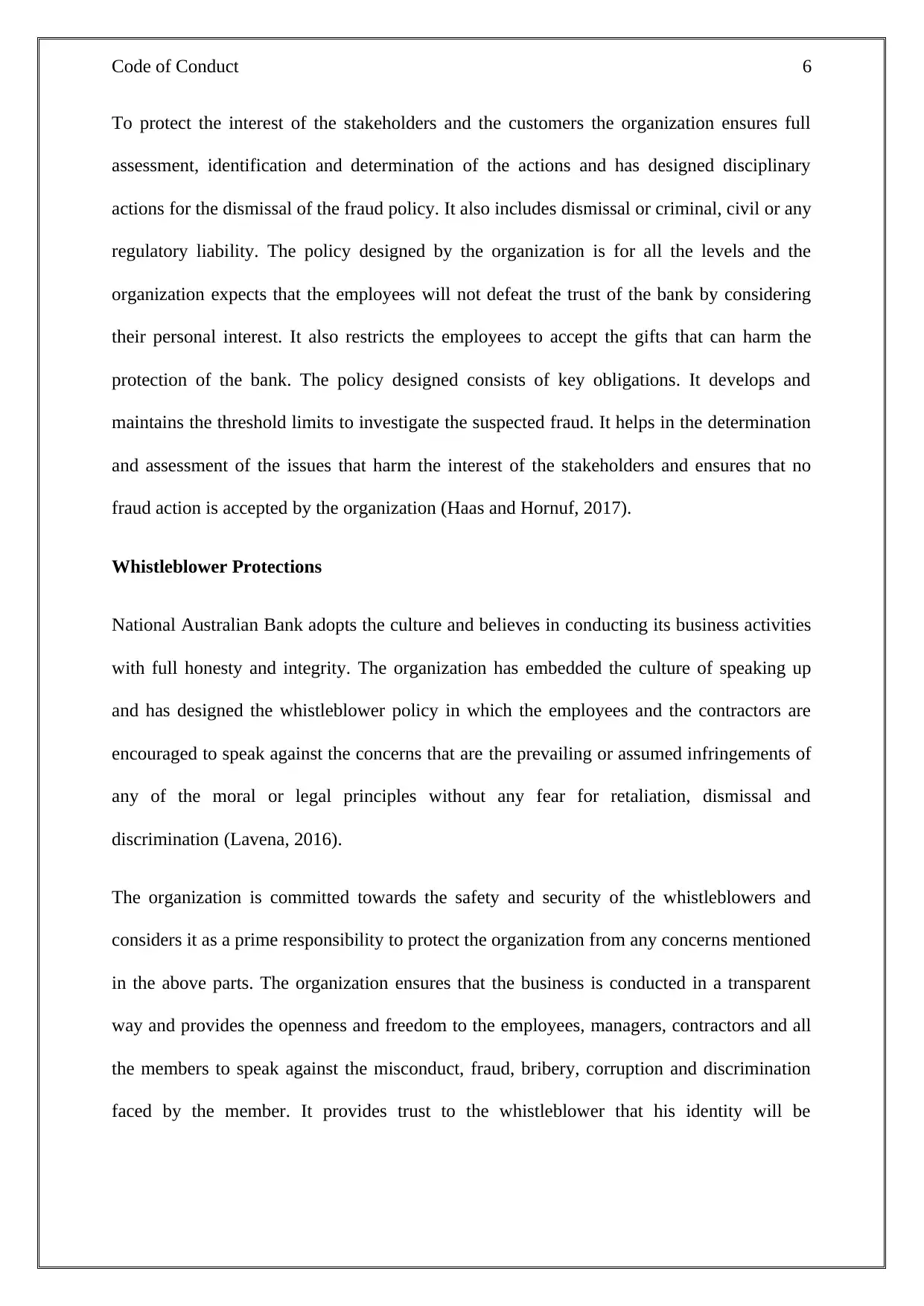
Code of Conduct 6
To protect the interest of the stakeholders and the customers the organization ensures full
assessment, identification and determination of the actions and has designed disciplinary
actions for the dismissal of the fraud policy. It also includes dismissal or criminal, civil or any
regulatory liability. The policy designed by the organization is for all the levels and the
organization expects that the employees will not defeat the trust of the bank by considering
their personal interest. It also restricts the employees to accept the gifts that can harm the
protection of the bank. The policy designed consists of key obligations. It develops and
maintains the threshold limits to investigate the suspected fraud. It helps in the determination
and assessment of the issues that harm the interest of the stakeholders and ensures that no
fraud action is accepted by the organization (Haas and Hornuf, 2017).
Whistleblower Protections
National Australian Bank adopts the culture and believes in conducting its business activities
with full honesty and integrity. The organization has embedded the culture of speaking up
and has designed the whistleblower policy in which the employees and the contractors are
encouraged to speak against the concerns that are the prevailing or assumed infringements of
any of the moral or legal principles without any fear for retaliation, dismissal and
discrimination (Lavena, 2016).
The organization is committed towards the safety and security of the whistleblowers and
considers it as a prime responsibility to protect the organization from any concerns mentioned
in the above parts. The organization ensures that the business is conducted in a transparent
way and provides the openness and freedom to the employees, managers, contractors and all
the members to speak against the misconduct, fraud, bribery, corruption and discrimination
faced by the member. It provides trust to the whistleblower that his identity will be
To protect the interest of the stakeholders and the customers the organization ensures full
assessment, identification and determination of the actions and has designed disciplinary
actions for the dismissal of the fraud policy. It also includes dismissal or criminal, civil or any
regulatory liability. The policy designed by the organization is for all the levels and the
organization expects that the employees will not defeat the trust of the bank by considering
their personal interest. It also restricts the employees to accept the gifts that can harm the
protection of the bank. The policy designed consists of key obligations. It develops and
maintains the threshold limits to investigate the suspected fraud. It helps in the determination
and assessment of the issues that harm the interest of the stakeholders and ensures that no
fraud action is accepted by the organization (Haas and Hornuf, 2017).
Whistleblower Protections
National Australian Bank adopts the culture and believes in conducting its business activities
with full honesty and integrity. The organization has embedded the culture of speaking up
and has designed the whistleblower policy in which the employees and the contractors are
encouraged to speak against the concerns that are the prevailing or assumed infringements of
any of the moral or legal principles without any fear for retaliation, dismissal and
discrimination (Lavena, 2016).
The organization is committed towards the safety and security of the whistleblowers and
considers it as a prime responsibility to protect the organization from any concerns mentioned
in the above parts. The organization ensures that the business is conducted in a transparent
way and provides the openness and freedom to the employees, managers, contractors and all
the members to speak against the misconduct, fraud, bribery, corruption and discrimination
faced by the member. It provides trust to the whistleblower that his identity will be
Paraphrase This Document
Need a fresh take? Get an instant paraphrase of this document with our AI Paraphraser
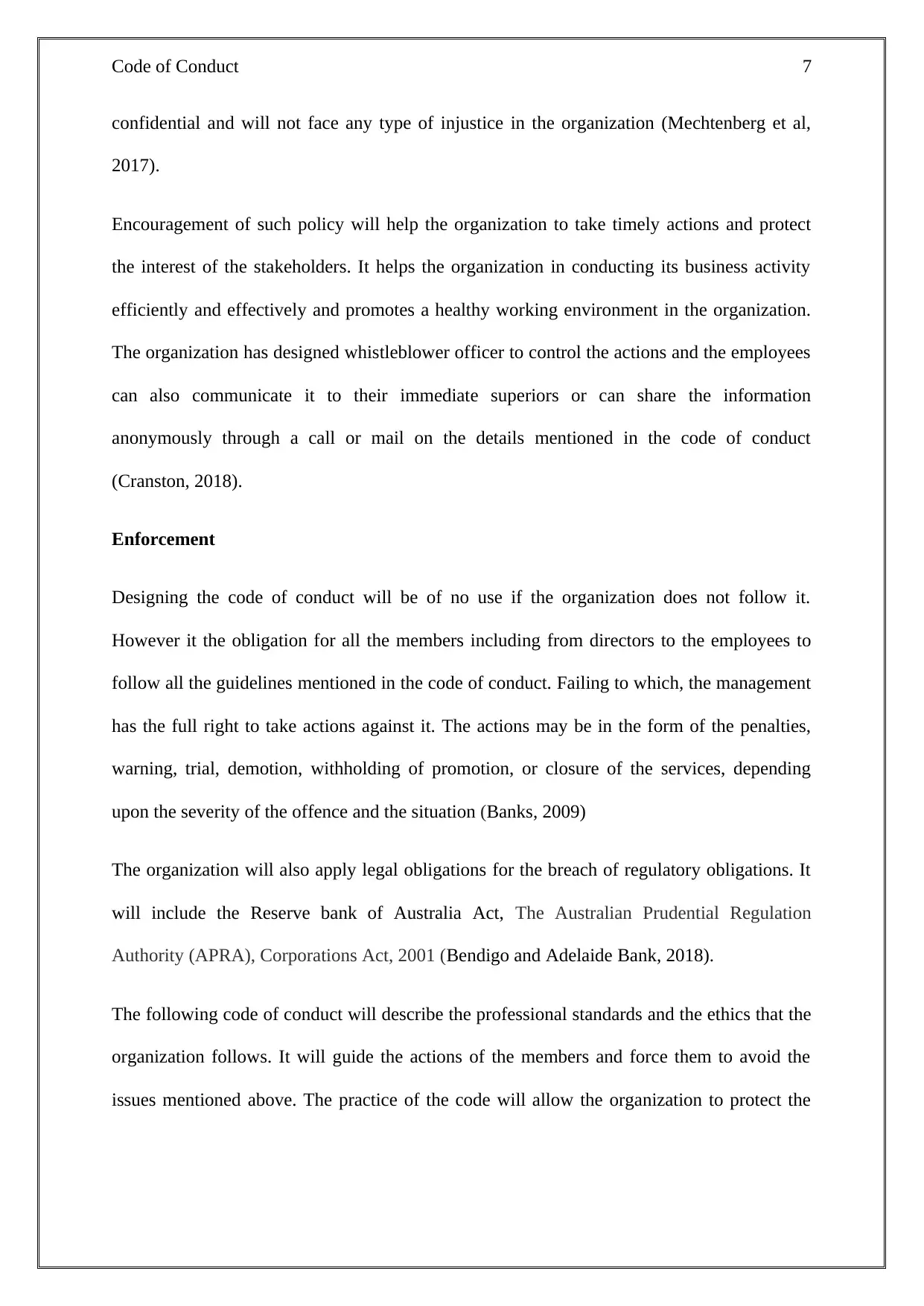
Code of Conduct 7
confidential and will not face any type of injustice in the organization (Mechtenberg et al,
2017).
Encouragement of such policy will help the organization to take timely actions and protect
the interest of the stakeholders. It helps the organization in conducting its business activity
efficiently and effectively and promotes a healthy working environment in the organization.
The organization has designed whistleblower officer to control the actions and the employees
can also communicate it to their immediate superiors or can share the information
anonymously through a call or mail on the details mentioned in the code of conduct
(Cranston, 2018).
Enforcement
Designing the code of conduct will be of no use if the organization does not follow it.
However it the obligation for all the members including from directors to the employees to
follow all the guidelines mentioned in the code of conduct. Failing to which, the management
has the full right to take actions against it. The actions may be in the form of the penalties,
warning, trial, demotion, withholding of promotion, or closure of the services, depending
upon the severity of the offence and the situation (Banks, 2009)
The organization will also apply legal obligations for the breach of regulatory obligations. It
will include the Reserve bank of Australia Act, The Australian Prudential Regulation
Authority (APRA), Corporations Act, 2001 (Bendigo and Adelaide Bank, 2018).
The following code of conduct will describe the professional standards and the ethics that the
organization follows. It will guide the actions of the members and force them to avoid the
issues mentioned above. The practice of the code will allow the organization to protect the
confidential and will not face any type of injustice in the organization (Mechtenberg et al,
2017).
Encouragement of such policy will help the organization to take timely actions and protect
the interest of the stakeholders. It helps the organization in conducting its business activity
efficiently and effectively and promotes a healthy working environment in the organization.
The organization has designed whistleblower officer to control the actions and the employees
can also communicate it to their immediate superiors or can share the information
anonymously through a call or mail on the details mentioned in the code of conduct
(Cranston, 2018).
Enforcement
Designing the code of conduct will be of no use if the organization does not follow it.
However it the obligation for all the members including from directors to the employees to
follow all the guidelines mentioned in the code of conduct. Failing to which, the management
has the full right to take actions against it. The actions may be in the form of the penalties,
warning, trial, demotion, withholding of promotion, or closure of the services, depending
upon the severity of the offence and the situation (Banks, 2009)
The organization will also apply legal obligations for the breach of regulatory obligations. It
will include the Reserve bank of Australia Act, The Australian Prudential Regulation
Authority (APRA), Corporations Act, 2001 (Bendigo and Adelaide Bank, 2018).
The following code of conduct will describe the professional standards and the ethics that the
organization follows. It will guide the actions of the members and force them to avoid the
issues mentioned above. The practice of the code will allow the organization to protect the
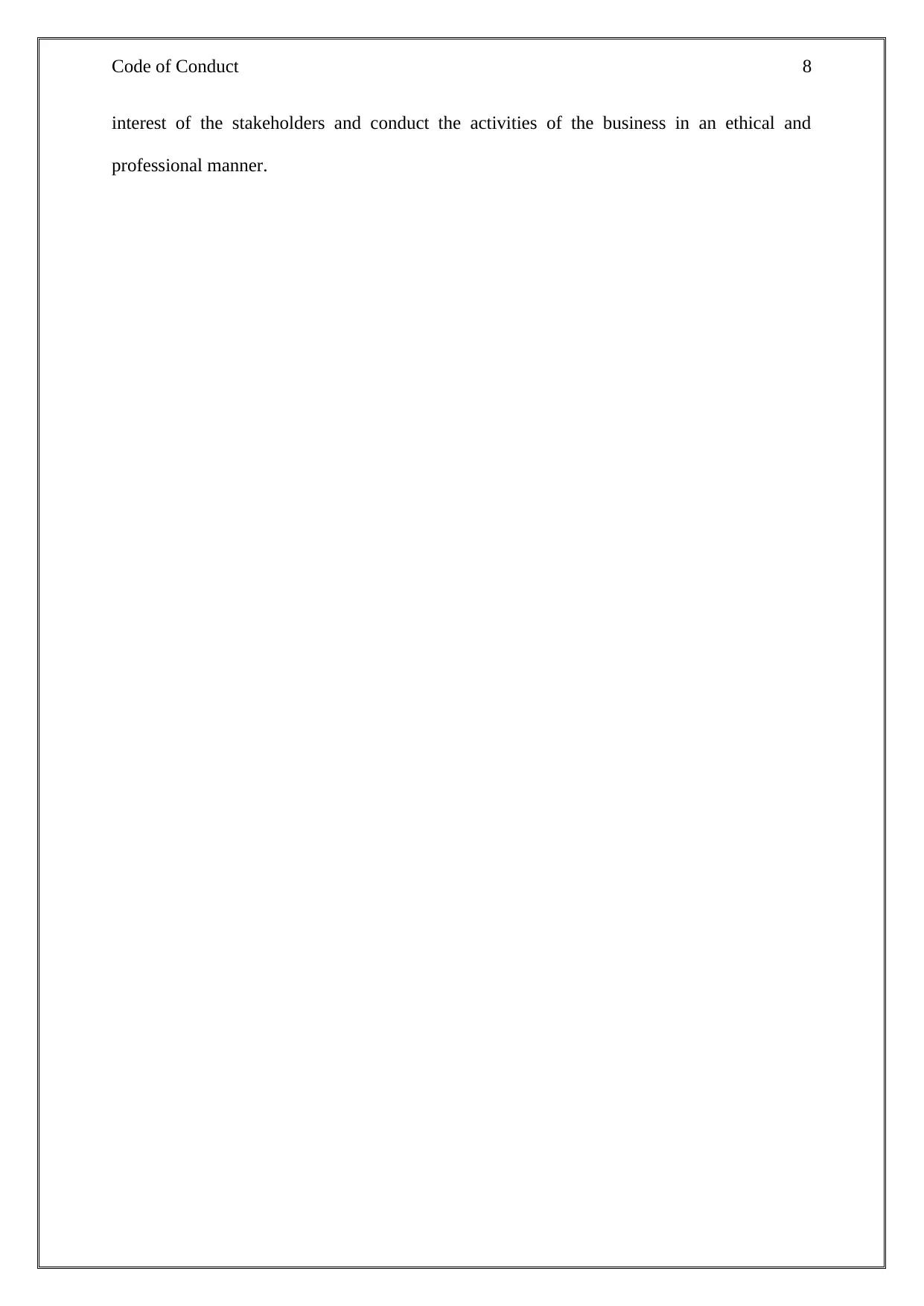
Code of Conduct 8
interest of the stakeholders and conduct the activities of the business in an ethical and
professional manner.
interest of the stakeholders and conduct the activities of the business in an ethical and
professional manner.
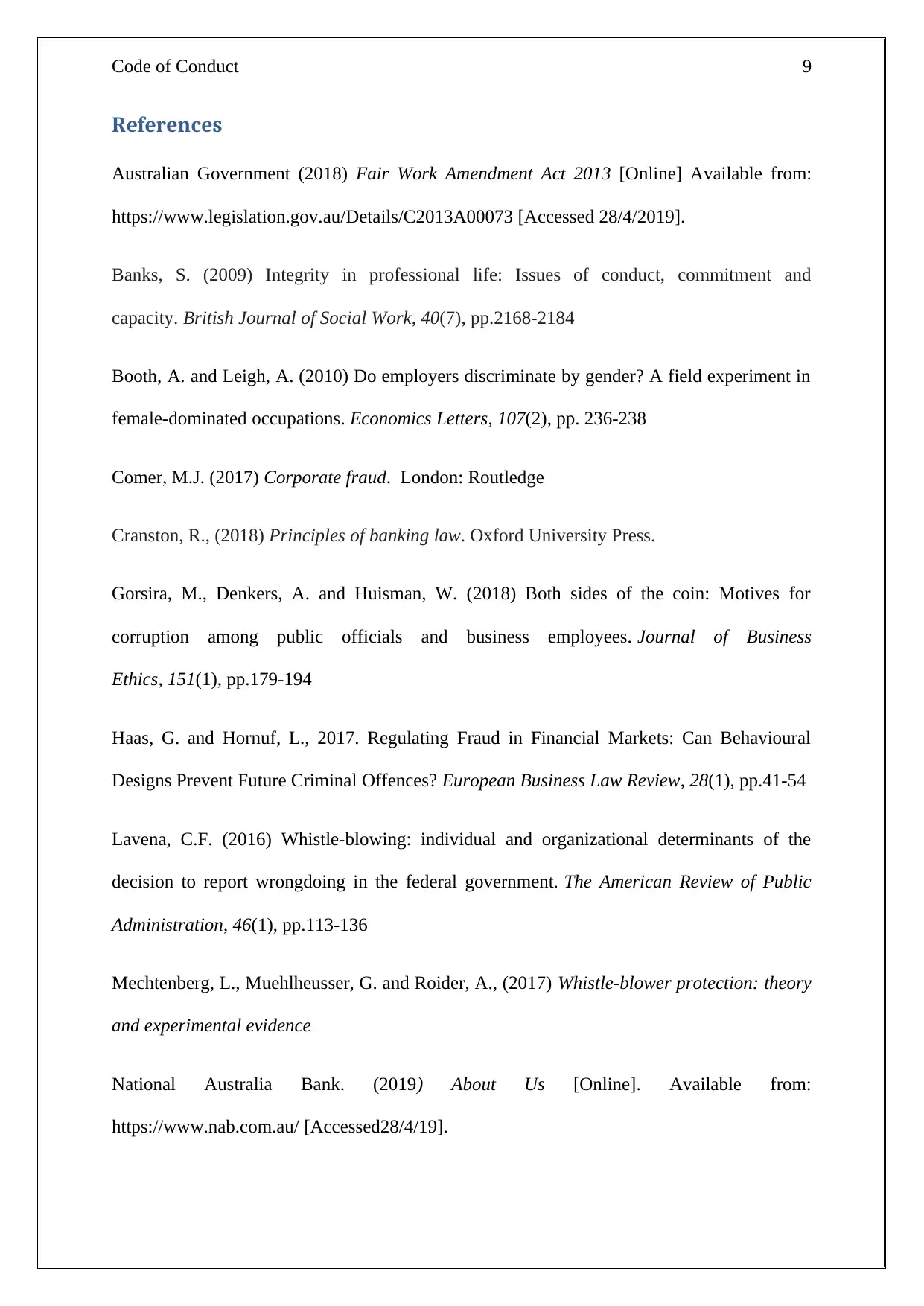
Code of Conduct 9
References
Australian Government (2018) Fair Work Amendment Act 2013 [Online] Available from:
https://www.legislation.gov.au/Details/C2013A00073 [Accessed 28/4/2019].
Banks, S. (2009) Integrity in professional life: Issues of conduct, commitment and
capacity. British Journal of Social Work, 40(7), pp.2168-2184
Booth, A. and Leigh, A. (2010) Do employers discriminate by gender? A field experiment in
female-dominated occupations. Economics Letters, 107(2), pp. 236-238
Comer, M.J. (2017) Corporate fraud. London: Routledge
Cranston, R., (2018) Principles of banking law. Oxford University Press.
Gorsira, M., Denkers, A. and Huisman, W. (2018) Both sides of the coin: Motives for
corruption among public officials and business employees. Journal of Business
Ethics, 151(1), pp.179-194
Haas, G. and Hornuf, L., 2017. Regulating Fraud in Financial Markets: Can Behavioural
Designs Prevent Future Criminal Offences? European Business Law Review, 28(1), pp.41-54
Lavena, C.F. (2016) Whistle-blowing: individual and organizational determinants of the
decision to report wrongdoing in the federal government. The American Review of Public
Administration, 46(1), pp.113-136
Mechtenberg, L., Muehlheusser, G. and Roider, A., (2017) Whistle-blower protection: theory
and experimental evidence
National Australia Bank. (2019) About Us [Online]. Available from:
https://www.nab.com.au/ [Accessed28/4/19].
References
Australian Government (2018) Fair Work Amendment Act 2013 [Online] Available from:
https://www.legislation.gov.au/Details/C2013A00073 [Accessed 28/4/2019].
Banks, S. (2009) Integrity in professional life: Issues of conduct, commitment and
capacity. British Journal of Social Work, 40(7), pp.2168-2184
Booth, A. and Leigh, A. (2010) Do employers discriminate by gender? A field experiment in
female-dominated occupations. Economics Letters, 107(2), pp. 236-238
Comer, M.J. (2017) Corporate fraud. London: Routledge
Cranston, R., (2018) Principles of banking law. Oxford University Press.
Gorsira, M., Denkers, A. and Huisman, W. (2018) Both sides of the coin: Motives for
corruption among public officials and business employees. Journal of Business
Ethics, 151(1), pp.179-194
Haas, G. and Hornuf, L., 2017. Regulating Fraud in Financial Markets: Can Behavioural
Designs Prevent Future Criminal Offences? European Business Law Review, 28(1), pp.41-54
Lavena, C.F. (2016) Whistle-blowing: individual and organizational determinants of the
decision to report wrongdoing in the federal government. The American Review of Public
Administration, 46(1), pp.113-136
Mechtenberg, L., Muehlheusser, G. and Roider, A., (2017) Whistle-blower protection: theory
and experimental evidence
National Australia Bank. (2019) About Us [Online]. Available from:
https://www.nab.com.au/ [Accessed28/4/19].
Secure Best Marks with AI Grader
Need help grading? Try our AI Grader for instant feedback on your assignments.
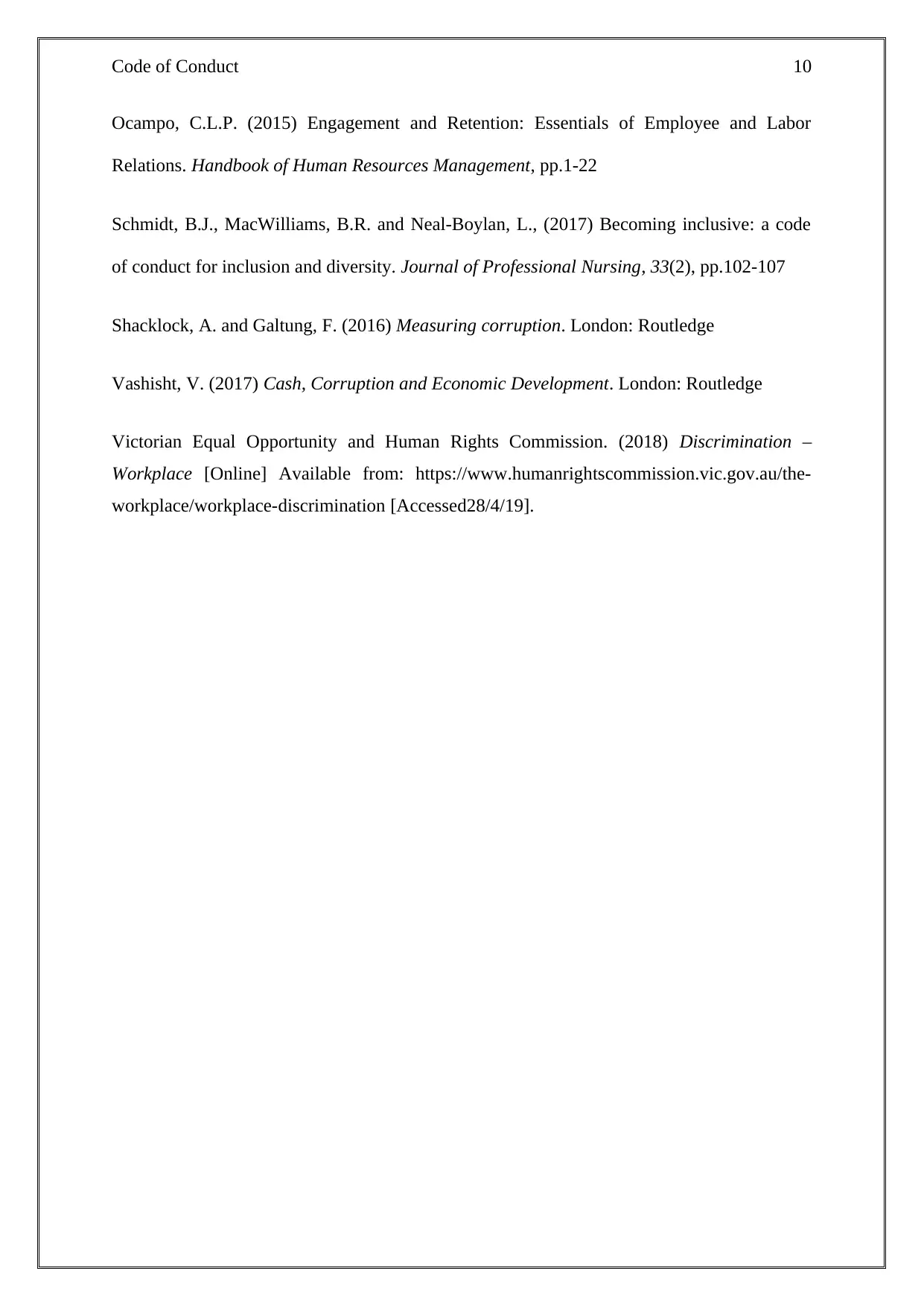
Code of Conduct 10
Ocampo, C.L.P. (2015) Engagement and Retention: Essentials of Employee and Labor
Relations. Handbook of Human Resources Management, pp.1-22
Schmidt, B.J., MacWilliams, B.R. and Neal-Boylan, L., (2017) Becoming inclusive: a code
of conduct for inclusion and diversity. Journal of Professional Nursing, 33(2), pp.102-107
Shacklock, A. and Galtung, F. (2016) Measuring corruption. London: Routledge
Vashisht, V. (2017) Cash, Corruption and Economic Development. London: Routledge
Victorian Equal Opportunity and Human Rights Commission. (2018) Discrimination –
Workplace [Online] Available from: https://www.humanrightscommission.vic.gov.au/the-
workplace/workplace-discrimination [Accessed28/4/19].
Ocampo, C.L.P. (2015) Engagement and Retention: Essentials of Employee and Labor
Relations. Handbook of Human Resources Management, pp.1-22
Schmidt, B.J., MacWilliams, B.R. and Neal-Boylan, L., (2017) Becoming inclusive: a code
of conduct for inclusion and diversity. Journal of Professional Nursing, 33(2), pp.102-107
Shacklock, A. and Galtung, F. (2016) Measuring corruption. London: Routledge
Vashisht, V. (2017) Cash, Corruption and Economic Development. London: Routledge
Victorian Equal Opportunity and Human Rights Commission. (2018) Discrimination –
Workplace [Online] Available from: https://www.humanrightscommission.vic.gov.au/the-
workplace/workplace-discrimination [Accessed28/4/19].
1 out of 11
Related Documents
Your All-in-One AI-Powered Toolkit for Academic Success.
+13062052269
info@desklib.com
Available 24*7 on WhatsApp / Email
![[object Object]](/_next/static/media/star-bottom.7253800d.svg)
Unlock your academic potential
© 2024 | Zucol Services PVT LTD | All rights reserved.





